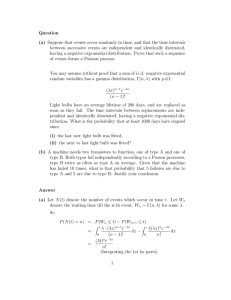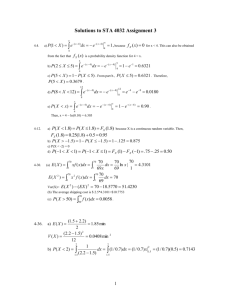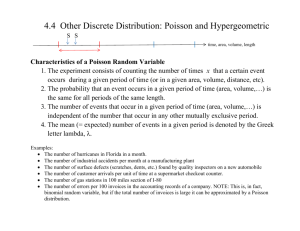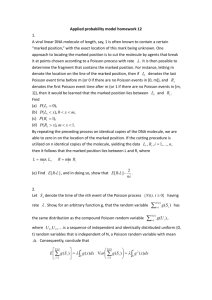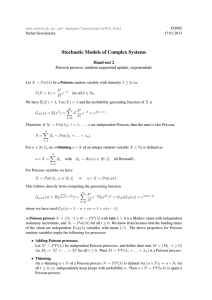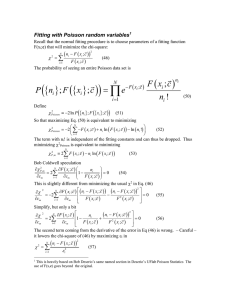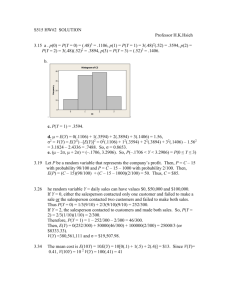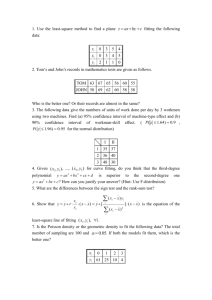Engineering Statistics 314 Tut 4 Memo 2008
advertisement
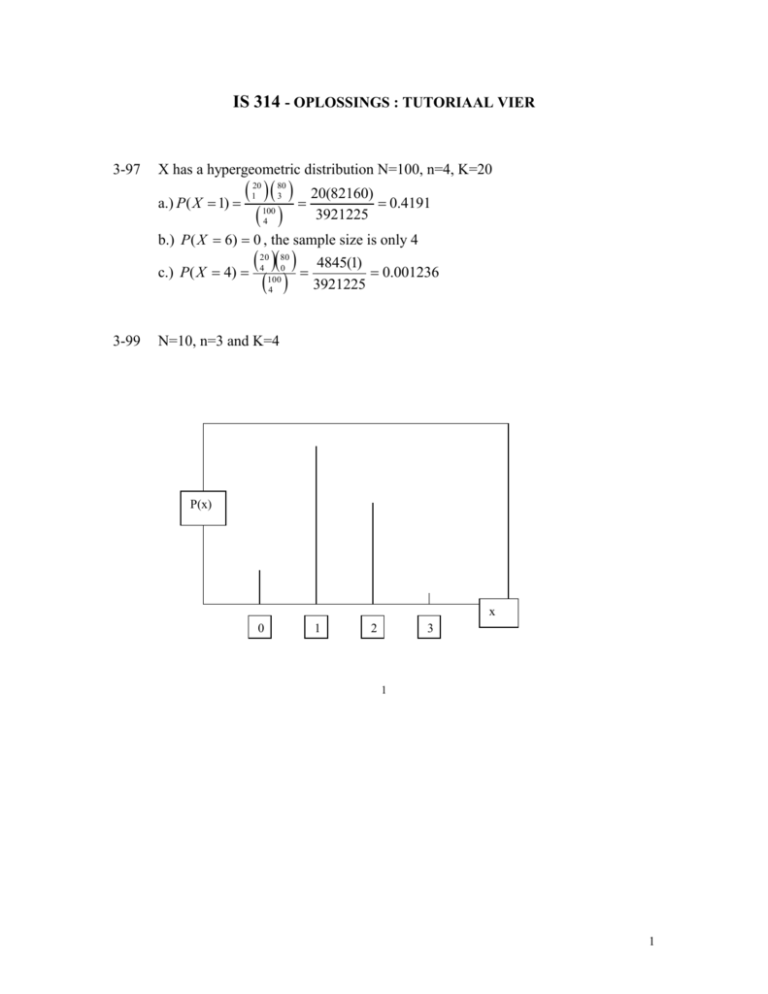
IS 314 - OPLOSSINGS : TUTORIAAL VIER 3-97 X has a hypergeometric distribution N=100, n=4, K=20 20(82160) 0.4191 a.) P( X 1) 3921225 20 1 80 3 100 4 b.) P ( X 6) 0 , the sample size is only 4 4845(1) 0.001236 c.) P( X 4) 3921225 20 80 4 0 100 4 3-99 N=10, n=3 and K=4 P(x) x 0 1 2 3 1 1 3-99(vervolg). 4 6 0 3 f (0) 0.1667, f (1) 10 3 4 6 2 1 0.3, f (3) f ( 2) 10 3 4 6 1 2 0.5, 10 3 4 6 2 1 0.0333 10 3 Dus volg: 0, 1 / 6, F ( x) 2 / 3, 29 / 30, 1, 3104 0 x 1 1 x 2 2 x 3 3 x x0 Let X denote the count of the numbers in the state's sample that match those in the player's sample. Then, X has a hypergeometric distribution with N = 49, n = 6, and K = 6. 49! 1 7.15 10 a) P( X 6) 6!43! 13,983,816 6 43 1.85 10 b) P( X 5) 9.686 10 c) P( X 4) 6 6 1 43 0 8 49 6 6 5 43 1 49 6 6 4 5 49 6 43 2 4 49 6 d) Let Y denote the number of weeks needed to match all six numbers. Then, Y 1 has a geometric distribution with p = and E(Y) = 1/p = 13,983,816 13,983,816 weeks. This is more than 2389 centuries! 2 e4 40 e4 0.0183 0! b) P( X 2) P( X 0) P( X 1) P( X 2) e4 41 e4 42 e4 1! 2! 0.2381 e4 44 c) P( X 4) 0.1954 4! e4 48 d) P( X 8) 0.0298 8! 3-107. a) P( X 0) 3-116. a) Let X denote the number of cracks in 5 miles of highway. Then, X is a Poisson random variable with = 10. P( X 0) e10 4.54 105 b) Let Y denote the number of cracks in a half mile of highway. Then, Y is a Poisson random variable with = 1. P(Y 1) 1 P(Y 0) 1 e1 0.6321 c) The assumptions of a Poisson process require that the probability of a count is constant for all intervals. If the probability of a count depends on traffic load and the load varies, then the assumptions of a Poisson process are not valid. Separate Poisson random variables might be appropriate for the heavy and light load sections of the highway. Section 4-2 4-1. a) P(1 X ) e x dx (e x ) e 1 0.3679 1 1 2.5 b) P(1 X 2.5) e x dx (e x ) 2.5 1 e1 e 2.5 0.2858 1 3 3 c) P( X 3) e x dx 0 3 4 d) P( X 4) e x dx (e x ) 1 e 4 0.9817 4 0 0 e) P(3 X ) e x dx (e x ) e3 0.0498 3 3 4-2. a) P( x X ) e x dx (e x ) e x 0.10 . x x Then, x = ln(0.10) = 2.3 x b) P( X x) e x dx (e x ) 1 e x 0.10 . x 0 0 Then, x = ln(0.9) = 0.1054 4-5 a) P(0 X ) 0.5 , by symmetry. 1 b) P(0.5 X ) 1.5 x 2 dx 0.5x3 1 0.5 0.5 0.0625 0.4375 0.5 0.5 c) P(0.5 X 0.5) 1.5x dx 0.5x 2 0.5 3 0.5 0.5 0.125 d) P(X < 2) = 0 e) P(X < 0 or X > 0.5) = 1 1 f) P( x X ) 1.5 x 2dx 0.5 x3 0.5 0.5 x3 0.05 1 x x Then, x = 0.9655 4-11. a) P( X 2.8) P( X 2.8) because X is a continuous random variable. Thus, P(X<2.8) = F(2.8) = 0.2(2.8) = 0.56. b) P( X 1.5) 1 P( X 1.5) 1 0.2(1.5) 0.7 c) P( X 2) FX (2) 0 d) P( X 6) 1 FX (6) 0 4 x 4-15. Now, f ( x) e x for 0 < x and FX ( x) e x dx e x x 0 1 e x 0 0, x 0 for 0 < x. Then, FX ( x) x 1 e , x 0 4-20. f ( x) 2e2 x , x 0 4 4 4-23. x2 E ( X ) 0.25 xdx 0.25 2 2 0 0 4 ( x 2)3 2 2 4 V ( X ) 0.25( x 2) dx 0.25 3 3 3 3 0 0 4 2 4 4 4-24. x3 E ( X ) 0.125 x dx 0.125 2.6667 3 0 0 2 4 x4 4 E X 0.125 x dx 0.125 |0 4 0 2 3 3.55559 Var X E X 2 2 0.88889 120 4-29. a.) E ( X ) x 100 120 600 120 dx 600 ln x 100 109.39 2 x V ( X ) ( x 109.39) 2 100 120 600 dx 600 1 x2 100 600( x 218.78 ln x 109.39 2 x 1 ) 2 (109.39) x 120 100 (109.39) 2 x2 dx 33.19 b.) Average cost per part = $0.50*109.39 = $54.70 5 4-31. a) E ( X ) x10e 10( x 5) dx . 5 Thus E ( X ) xe 10( x 5 ) 5 e 5 EX 10( x 5 ) e 10( x 5) dx 5 10 5.1 5 2 x 10 exp 10 x 5 dx 2 5 Further x 2 [ exp 10 x 5 ]5 2 x exp 10 x 5 dx 5 5.1 25 1 2 from 5.1 10 26.02 Thus 2 E X 2 2 26.02 5.12 0.01 b) P( X 5.1) 10e ( x 5) dx e 10( x 5) 5.1 e 10(5.15) 0.3679 5.1 6

